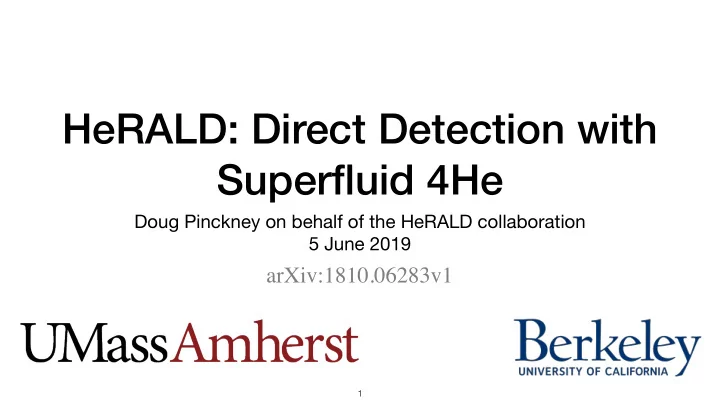

HeRALD: Direct Detection with Superfluid 4He Doug Pinckney on behalf of the HeRALD collaboration 5 June 2019 arXiv:1810.06283v1 � 1
HeRALD: Helium Roton Apparatus for Light Dark matter Calorimeters • Superfluid 4He as a target material • Favorable recoil kinematics Vacuum gap • Recoil energy can be fully reconstructed with TES calorimetry • Zero bulk radiogenic backgrounds Superfluid 4He • No Compton backgrounds below 20 eV • HERON experiment at Brown (Seidel, Maris), proof of concept work � 2
Excitations in Superfluid 4He Detection Method Excitation Adsorption of quantum ~meV Vibrations evaporated He atoms on O(ns) DM (phonons, rotons) upper calorimeter + adhesion gain, 10-100 ms timescale Singlet UV (16 eV) He Absorbed in calorimeters on Photons 10 ns timescale Ballistic, travel at Triplet Kinetic O(1 m/s), deposit energy in Excitations immersed calorimeters � 3
Blue = quasiparticle Energy Partitioning Red = Singlet Green = Triplet Grey = IR photon • Nuclear and electron recoils have di ff erent energy partitioning! • Estimated from measured excitation/ionization cross sections • Compared to other noble elements, lots of energy goes into atomic excitations • Distinguishable with signal timing Active veto for recoils less than 20 eV � 4
Activities at Berkeley Blue = quasiparticle Red = Singlet Green = Triplet • Measuring the light yield for nuclear recoils in 4He (red curve) Grey = IR photon • Neutron scattering experiment at room and cryogenic temperatures From V. Velan � 5
Background Simulations • Uncertainty in neutron flux spectrum low energy • Radon surface backgrounds not yet considered Gamma-NR 1 kg underground target Gamma-e Solar Neutrino Gamma-e discrimination Thompson Neutron Rayleigh Delbruck � 6
Sensitivity Projections Astrophysics • Solid red curve, 1 kg-day @ 40 eV threshold 1 kg-day 40 eV • 3.5 eV (sigma) Direct Detection calorimeter resolution 100 kg-yr • 9x “adhesion gain” 1 meV Bulk Fluid • 5% quasiparticle detection e ffi ciency Neutrino Floor � 7
Activity at UMass Evaporator Condenser Surface Surface • Uncertainty in how quasiparticles, triplet excitations interact at surfaces • 24 keV neutron calibration source • Adhesion gain: keep calorimeter dry and use materials with higher van der waals attraction • Adapting the HERON film burner design, demonstrated but heat load problematic � 8
Heat Load Free Film Stopping • Cesium coated surfaces, demonstrated but technically di ffi cult • Atomically sharp knife edges, used by x-ray satellites at higher temperatures, has yet to be conclusively demonstrated Trench Cross-section � 9
Next Steps Quasiparticle Reflection Dilution He Film Stopping Refrigerator UMass Arrives Adhesion Gain ~1 month 24 keV neutron calibration source Scintillation yield measurements Berkeley Commissioning a dilution refrigerator (calorimetry) � 10
Extras � 11
From Scott Hertel � 12
Film Burner Model Experimental film stoppage area Condenser Surface Evaporator Surface Condenser Surface � 13
Excitations in Superfluid 4He Detected State Vibrations Vibrations (phonons, rotons) (phonons, rotons) DM Excitations Dimer Excimers Singlet UV Photons He He* He* He Triplet Kinetic Excitations (IR Photons) He + e - Ionization � 14
Sensitivity Projections Cont. Curve Exposure Threshold Solid Red 1 kg-day 40 eV Dashed Red 1 kg-yr 10 eV Dotted Red 10 kg-yr 0.1 eV Dashed-Dotted 100 kg-yr 1 meV Red Neutrino Floor Dashed- + o ff shell phonon 100 kg-yr 1 meV Dotted-Dotted sensitivity Red � 15
Extending Sensitivity with Off Shell Interactions • The 0.6 meV evaporation threshold limits nuclear recoil DM search to m DM >~ 1 MeV • Can be avoided if we find an excitation with an e ff ective mass closer to the DM mass, allow DM to deposit more energy in the detector • In helium this could be recoiling o ff the bulk fluid and creating o ff shell quasiparticles � 16
Detecting Vibrations: Vibrations in Helium • The vibrational (“quasiparticle”, “QP”) excitations we expect to see are phonons and rotons • Velocity is slope of dispersion relation • Rotons ~ “high momentum phonons” • Just another part of the same dispersion relation • R- propagates in opposite direction to momentum vector � 17
Distinguishing Quasiparticles and Excitations • Use signal timing • Singlet signal expected to have O(10 ns) fall time, delta function in calorimeter • Triplets have O(1 m/s) velocity, observed as a delta function mostly in immersed calorimetry • Quasiparticles signal expected to have O(10-100 ms) fall time, mostly observed on surface calorimeter spread out � 18
Example Waveform • Based on HERON R&D HERON DATA • Can distinguish scintillation and evaporation based on timing 365 keV electron recoil J. S. Adams et al. AIP Conference Proceedings 533, 112 (2000) Annotations from Vetri Velan � 19
Another Example Waveform • Distinguish between di ff erent phonon distributions by arrival time in detector • R+ arrive first • P travel at a mix of slower speeds and arrive next • R- can’t evaporate directly, need reflection on bottom to convert into R+ or P Recent Quasiparticle Simulation p 0 R+ P R- p 1 p 2 � 20
� 21
� 22
Recommend
More recommend